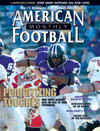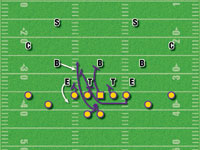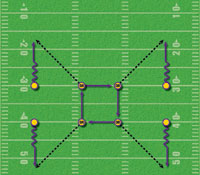AMERICAN FOOTBALL MONTHLY THE #1 RESOURCE FOR FOOTBALL COACHES
Article CategoriesAFM Magazine
|
How to Get Your Gamebreakers the Ballby: Michael Parker© More from this issue University of North Alabama coach Mark Hudspeth has been coaching football in the South for awhile. “I grew up just south of Starkville, Mississippi, watching Emory Bellard run the option. So, I have been an option guy from way back.” Hudspeth has learned that the basic premise behind Bellard’s famous Wishbone offense, developed and implemented under Darrell Royal at Texas, is ball distribution and having the defense decide where the ball goes. Since Hudspeth’s arrival in 2002, the UNA Lions have taken that concept and run with it. And passed from it. They have gone 40-10 over the past four seasons and have proved that other systems besides the Wishbone can – and do – make it possible to distribute the ball to the players that can make things happen. “First and foremost, we understand that it isn’t the X's and O's, it’s the Jimmy’s and Joe’s. No matter what offense you run in order to be successful you need talented players,” says Hudspeth. “In today’s game a lot of people have players. But what we have found out is instead of worrying so much about what plays to call we concentrate on plays to get the ball in the hands of our playmakers.” 3 STEPS TO IMPLEMENTING THE “PLAYMAKER” strategy “We’re a four wide, no-huddle, shotgun football team whose primary strategy is to stretch the field horizontally and vertically and make the defense cover the entire field. Then we take it a step further; we call our plays and tweak our schemes to fit our top personnel and to try to find ways that they can help and fit into our game plan,” says Hudspeth. The 3 Steps: 1. “We start with the offensive philosophy first.” 2. “Then we take it a step further and pinpoint our playmakers.” 3. “We make sure we have a plan for the playmakers to get the touches that we feel like it takes to win the football game.” “The thing that has made us successful is that we have identified our players every year that need to touch the ball; we have found ways to get them the ball. Our offense is not built around just throwing one guy the ball the entire game.” OFFENSIVE SCHEME – GETTING YOUR PLAYMAKERS THE BALL North Alabama runs a form of the spread offense that is terrorizing defenses all over the country. And just like all those other spread-type offenses, they have some staples – such as the zone play – in the run game. But, other than the typical inside/outside zone plays, Hudspeth also utilizes the following plays to get the ball into the right hands at just the right time. THE DART “First and foremost, our RB scheme doesn’t change all that much. We feel like we’ll always have at least an adequate RB. There are a lot of good RBs out there,” says Hudpseth. “Besides the zone play, we’re going to run the Dart. Those are our two main run schemes. The scheme of the Dart is basically block Iso frontside and pull the backside tackle. You are out on the 5 technique, you double the nose up to the backside LB, and you wrap your backside tackle all the way around to the frontside B Gap. It is a counter play for our zone,” says Hudspeth (See Diagram 1).
And while it is always easy to give a great RB the ball by just turning around and handing it to him, the challenge can be to feed a great WR. “We want to find ways to get the ball to our WRs who have been some of our better players here in the last four or five years,” says Hudspeth. “We’re going to motion our WRs back to the backfield as RBs. And run the stretch, and speed options. Things like that.” THE JET SWEEP “The way we do that is we also run the Jet Sweep to our wide receivers. The blocking schemes are all very similar and so it ties in nicely. We feel like when we run the Jet Sweep, we only have to block at the point of attack to have a chance to be successful,” says Hudspeth. “If you can really get a point where it is timed up nicely, you can really stretch the defense horizontally. There are a lot of plays that you can come back and counter from off the Jet Sweep whether it’s bootlegs, whether it’s the Dart play, or whether it’s play action. There are lots of things you can do once you establish the Jet Sweep,” says Hudspeth (See Diagram 2).
THE SCREEN GAME “Then the next thing we’ll do with our key players is to run the screens to them. We are going to put the ball in their hands those ways: Bubble Screens to the inside guys and Tunnel Screens to the outside guys. Things like that,” says Hudspeth. “Most WRs aren’t very good at running the ball between the tackles. But obviously they’re fast and a lot of those guys have great speed and can circle the defense. “The next thing would be special plays, depending whether or not it is the reverse off the inside zone where you fake the zone and then turn and hand the ball to the WR coming around full speed. Then we have reverses, double passes,” he says. THE PASSING GAME “If you have a great WR, and you are a passing team, there are a lot of things that can keep that receiver from catching the ball. He may be covered. The QB may get pressured or sacked. The throw could be inaccurate. There are a lot of factors. But if you have a very talented WR that can really run, we want to find more ways than just counting on 5 step and 3 step drops; that is, hoping the progression comes to him, hoping that the protection is good, hoping that the coverage allows him to catch the ball. We want to put the ball in his hands and find a way he can help us more than just by catching three-four balls a game,” says Hudspeth. UNA’s SECRET TO GETTING A STAR WR THE BALL “One of the things that we do is line those guys up in different places. Our WRs line up in every position. They have to know all positions. There is a bit of a learning curve early, but once they understand our concepts then it really becomes easy when you have injuries. We can substitute because now they can all be interchangeable and they can all play all the positions. You don’t have to worry about ‘Hey, we can’t move this kid here because he doesn’t know the routes.’ That gives us a chance to move them around and maybe move them inside to get them lined up on a LB. And then we put them in a position to run screens or to run the Jet Sweep,” says Hudspeth. PRACTICE SCHEDULE UNA has found that one of the keys to preparing for a game, where a certain player must be an integral part of the plan, is in ensuring that player gets a significant number of touches in practice during the week. Hudspeth has achieved this as a natural result of the style of offense they run. “One of the biggest advantages being a no-huddle team gives us is the amount of reps that we get in practice. In practice we never huddle. We line up to run a play and get up off the ground and run the next play. For skelly, it is the same way. So we feel like we are getting a great number of reps in practice over the course of the season. In essence, we cut down our practice time. That’s because we can get the same number of reps in a shorter amount of time. “We’ve all been in huddles, and you go to the line and you’re ready to run a play and the offensive line coach yells for you to get back in the huddle. By the time you get back to the huddle and recall the play, we’ve already run four plays. “We have about 20 minutes of individual drills, then 10 minutes of an inside run drill, while the WRs are in one-on-one drills with the DBs. Then we hit punt for 10 minutes. At the same time, we are doing screens/draw with our offensive players. Then skelly for 15 minutes. Then more special teams for 10. Then team O. “We like to go pat-n-go but during the game you don’t get to pat-n-go all that much. We just want to make sure the players are catching a bunch of passes during the week. We have a special drill that we run before practice to make sure that our QBs and WRs get plenty of throws in. And if you are going to be good at throwing screens and throwing the quick game to the point where you are accurate with it, it takes work and it takes timing. We are going to try and get as many throws as we can early in practice and strive for perfection every day, trying to build confidence and increase our ball skills.” The Lions run a pre-practice drill with four rotating stations for the backs and receivers. They work on a specific aspect of the passing game plan that they will use in the upcoming week. The routes the players run varies depending on what plays will be emphasized during the game (See Diagram 3).
GAME PLANNING/ PLAY CALLING “Kenny Edenfield is our offensive coordinator. He is in the press box and calls the play and I signal it in. I also coach the QBs so I am totally aware of what is going on,” says Hudspeth. “The main way that we make adjustments is that we try to have a counter for everything that the defense is trying to do to us to stop what we are doing. If we see that the frontside LB is really overscraping on the stretch, or overrunning the zone, then we know we want to come back with a Dart or some type of counter. So what the defense does dictates a lot of what we’re going to call in the upcoming play or upcoming series.” Coaches may be concerned if the opponent knows that they are focusing on using a particular star player in the game. Hudspeth feels that is a huge advantage. “If a team tries to take away one player in the game, then they are definitely giving up something else. The whole premise of our offense is to take what the defense will give us. There may be a game where we only throw the ball 15 times a game. But if the passing game is going well, we may throw it 45 times. It is all predicated on the defense,” says Hudspeth. In his years coaching football, and at UNA especially, Hudspeth has learned that you can be successful if you stick to what you really believe in. “We are all sometimes guilty of not having enough courage or creativity to try something new to get your playmakers the ball. Everybody in the country will run the zone and if it gains one yard, they will still run it 24 more times. But if you come out and throw a screen and the defense sniffs it out for no gain, then everyone in the press box is panicking and you never run it again. But if you come back and call it again, you might hit a big play. So we try to not let things like that discourage us from doing things we want to do.” |
|
| HOME |
MAGAZINE |
SUBSCRIBE | ONLINE COLUMNISTS | COACHING VIDEOS |
Copyright 2024, AmericanFootballMonthly.com
All Rights Reserved







